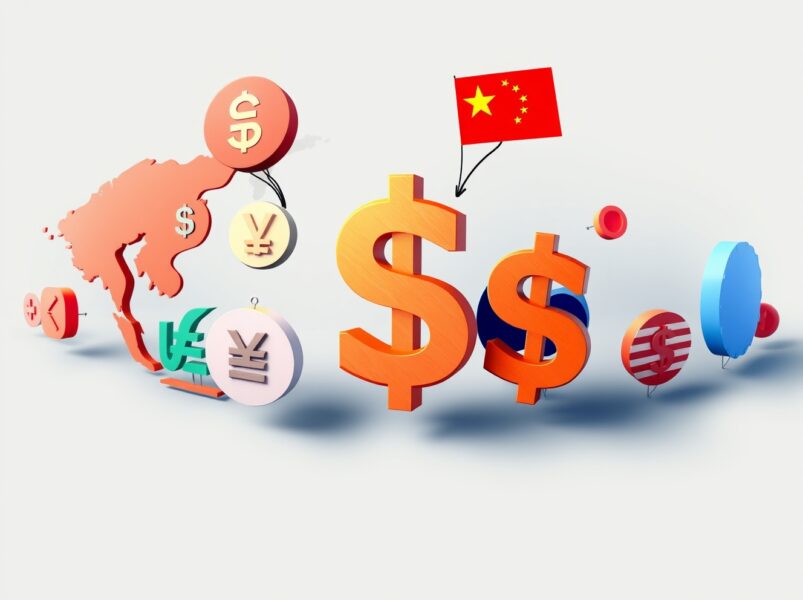Asia FX: Crucial Shifts as US Dollar Gains and Trade Tensions Ease
0
0

BitcoinWorld
Asia FX: Crucial Shifts as US Dollar Gains and Trade Tensions Ease
For many in the cryptocurrency space, understanding global macroeconomics might seem secondary to charting Bitcoin’s next move. However, the recent dynamics in Asia FX, the strengthening US Dollar, and easing trade tensions offer a crucial lens through which to view broader market sentiment and capital flows. These shifts, particularly the weakening Japanese Yen, don’t just affect traditional markets; they ripple into the digital asset landscape, influencing everything from stablecoin demand to risk appetite among institutional investors. Let’s delve into these pivotal movements in the global forex market and uncover their profound implications for both traditional and digital economies.
Understanding the Muted Moves in Asia FX
The Asian foreign exchange market has recently experienced a period of relative quietude, a stark contrast to the volatility often seen in global financial landscapes. While some might interpret ‘muted’ as stagnant, it often signals a complex interplay of forces that prevent dramatic directional moves. Several factors contribute to this subdued performance among Asian currencies.
- China’s Economic Influence: As the region’s economic powerhouse, China’s economic data significantly impacts its neighbors. Recent indicators suggesting a moderate pace of growth or targeted stimulus measures can lead to a cautious approach from investors, thereby limiting significant swings in regional currencies.
- Central Bank Policies: Many Asian central banks are carefully balancing inflation concerns with supporting economic growth. Their measured policy responses, often in sync with global trends but tailored to local conditions, contribute to a sense of stability, albeit a muted one, in their respective currencies.
- US Dollar Strength: A strong US Dollar typically puts downward pressure on other currencies, including those in Asia. As the dollar gains ground, Asian currencies may find it challenging to appreciate significantly, leading to a more subdued trading environment.
This muted environment means that while there aren’t massive rallies or crashes, underlying currents are still at play, subtly influencing trade balances, investment flows, and ultimately, the purchasing power of these currencies.
The Resilient Rise of the US Dollar: What’s Driving It?
The US Dollar has once again demonstrated its enduring strength, climbing against a basket of major currencies. This resilience is not accidental but is underpinned by several powerful economic and geopolitical forces that cement its status as the world’s primary reserve currency and a safe haven asset. Understanding these drivers is key to grasping broader market dynamics.
Key Drivers of Dollar Strength:
- Interest Rate Differentials: The Federal Reserve’s relatively hawkish stance compared to other major central banks creates a yield advantage for dollar-denominated assets. Higher interest rates attract capital, increasing demand for the dollar.
- Economic Resilience: Despite global uncertainties, the US economy has shown remarkable resilience, often outperforming expectations. Strong labor market data, robust consumer spending, and consistent GDP growth provide a solid foundation for investor confidence in US assets.
- Safe-Haven Demand: In times of geopolitical instability or global economic slowdowns, investors flock to the perceived safety of the US Dollar. Its deep liquidity and the stability of the US financial system make it an attractive refuge for capital.
- Global Trade Dominance: A significant portion of international trade, especially in commodities like oil, is denominated in dollars. This constant demand for the dollar for transactional purposes provides a structural floor for its value.
The dollar’s upward trajectory has far-reaching implications, from making imports cheaper for the US to increasing the cost of dollar-denominated debt for emerging markets. For crypto investors, a strong dollar can sometimes correlate with a risk-off sentiment, potentially impacting Bitcoin and altcoin prices, as capital seeks less volatile assets.
Easing Trade Tensions: A Breath of Fresh Air for Markets?
For years, global markets have been gripped by the specter of escalating trade tensions, particularly between major economic blocs. The imposition of tariffs, retaliatory measures, and protectionist rhetoric created significant uncertainty, impacting supply chains, corporate profits, and overall economic growth. Recently, however, there’s been a noticeable shift towards a more conciliatory tone, leading to a cautious optimism in financial circles.
Impact of Cooling Trade Rhetoric:
- Improved Business Confidence: Reduced uncertainty around trade policies encourages businesses to invest, expand, and plan for the long term, rather than adopting a wait-and-see approach.
- Stabilized Supply Chains: Companies can re-evaluate and optimize their global supply chains without the constant threat of sudden tariff changes, leading to greater efficiency and potentially lower costs.
- Boost to Global Trade Volumes: As barriers are lowered or stabilized, the flow of goods and services across borders tends to increase, stimulating economic activity worldwide.
- Enhanced Investor Appetite: A more predictable trade environment reduces systemic risk, making investors more willing to allocate capital to riskier assets, including equities and potentially cryptocurrencies.
While complete resolution of all trade disputes remains a distant goal, the current trend of easing tensions provides a much-needed psychological boost to markets. It signals a potential return to more predictable international economic relations, which is generally positive for growth and stability, fostering a more favorable environment for various asset classes.
The Curious Case of the Weakening Japanese Yen
Amidst a generally strong US Dollar and shifting global dynamics, the Japanese Yen has stood out for its continued weakness. This depreciation is not merely a consequence of external factors but is deeply rooted in Japan’s unique monetary policy stance and domestic political landscape. Investors are closely watching the upcoming Prime Ministerial vote, which could signal future policy directions.
Factors Contributing to Yen Weakness:
- Divergent Monetary Policy: The Bank of Japan (BoJ) has maintained an ultra-loose monetary policy, including negative interest rates and yield curve control, while other major central banks have been hiking rates. This vast interest rate differential makes the yen less attractive for carry trades and investment.
- Inflationary Pressures: While inflation has picked up in Japan, it has not reached the persistent levels seen in other economies that would compel the BoJ to tighten policy significantly.
- Trade Balance: Japan’s trade balance can fluctuate, and persistent deficits (where imports exceed exports) can put downward pressure on the currency as more yen are sold to buy foreign goods and services.
- Political Uncertainty (PM Vote): The upcoming Prime Ministerial vote introduces an element of political uncertainty. While Japan’s political system is generally stable, any perceived shift in leadership or policy direction can influence market sentiment towards the yen. Investors will be looking for clues on whether the new leadership might push for changes in economic policy, potentially impacting the BoJ’s stance.
A weaker yen makes Japanese exports more competitive but increases the cost of imports, particularly energy. For global investors, the yen’s movements are a critical indicator of carry trade sentiment and broader risk appetite, impacting flows into other assets, including those in the digital space.
Navigating the Global Forex Landscape: Strategies for Investors
The interconnected nature of the global forex market means that movements in one currency pair can ripple across others, influencing commodity prices, equity markets, and even the nascent cryptocurrency sector. For investors, understanding these dynamics is not just academic; it’s essential for crafting robust strategies.
Actionable Insights for Navigating Forex Markets:
- Monitor Interest Rate Differentials: Pay close attention to central bank policies and interest rate expectations across major economies. Currencies of countries with higher or rising rates tend to attract capital.
- Track Economic Data: Key economic indicators like GDP growth, inflation, employment figures, and trade balances provide vital clues about a country’s economic health and its currency’s potential direction.
- Geopolitical Awareness: Global events, from trade negotiations to political elections, can trigger significant currency movements. Staying informed about these developments is crucial.
- Diversification: While focusing on specific currency trends, consider how a diversified portfolio, including a mix of traditional assets and digital assets, can mitigate risks associated with currency volatility.
- Understand Carry Trades: Be aware of the implications of carry trades, where investors borrow in low-interest-rate currencies (like the yen) to invest in higher-yielding ones. Shifts in interest rate expectations can unwind these trades quickly.
For those in the crypto space, understanding the strength of the US Dollar can be particularly insightful, as it often dictates the broader risk-on/risk-off environment. When the dollar strengthens, it can sometimes indicate a flight to safety, which might lead to reduced appetite for riskier assets like altcoins. Conversely, a weakening dollar could signal increased risk appetite, potentially benefiting digital assets.
Conclusion: Interconnected Markets and Future Outlook
The recent period of muted Asia FX, the persistent strength of the US Dollar, easing trade tensions, and the distinct weakening of the Japanese Yen collectively paint a picture of a global financial landscape in constant flux. These movements are not isolated events but are deeply interconnected, reflecting a complex web of economic policies, geopolitical developments, and investor sentiment. For both traditional and digital asset investors, staying abreast of these macro trends is paramount. The interplay between central bank actions, economic performance, and international relations will continue to shape currency valuations, influence capital flows, and ultimately dictate the broader market environment. As we look ahead, the resilience of the dollar, the nuanced shifts in trade relations, and the evolving policies of Asian central banks will remain critical focal points, offering both challenges and opportunities across all investment horizons.
To learn more about the latest Forex market trends, explore our article on key developments shaping the US Dollar and Japanese Yen liquidity.
This post Asia FX: Crucial Shifts as US Dollar Gains and Trade Tensions Ease first appeared on BitcoinWorld.
0
0
 Manage all your crypto, NFT and DeFi from one place
Manage all your crypto, NFT and DeFi from one placeSecurely connect the portfolio you’re using to start.




